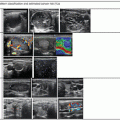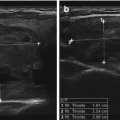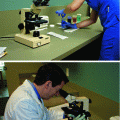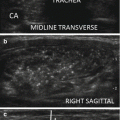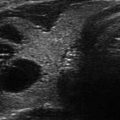Mutation testing
mRNA gene expression classifier
miRNA classifier
Test
ThyroSeq v2
ThyGenX
Thyroid Cancer Mutation Panel
Afirma
ThyraMIR (offered as reflex test if ThyGenX test is negative)
RosettaGX Reveal
Company
UPMC, via CBLPath
Interpace Diagnostics
Quest
Veracyte
Interpace Diagnostics
Rosetta Genomics
Methodology
Next-generation sequencing
Next-generation sequencing
Real-time PCR, pyrosequencing
mRNA expression array
qRT-PCR
qRT-PCR
Number of targets tested
Hotspot mutations in 14 genes and 42 types of gene fusions involving RET, PPARG, NTRK1, NTRK3, BRAF, THADA, and ALK genes
Hotspot mutations in five genes and RET/PTC1, RET/PTC3, PAX8/PPARG fusions
Hotspot mutations in four genes and RET/PTC1, RET/PTC3, PAX8/PPARG fusions
142 mRNAs
Ten miRNAs
24 miRNAs
Sample requirements
1–2 drops from first FNA pass into collection tube
One dedicated FNA pass into collection tube
Needle washing in alcohol-based fixative (eg., Cytolyt), two unstained tissue slides, or four unstained FNA slides
Two dedicated FNA passes into collection tube
One dedicated FNA pass into collection tube
One stained FNA smear slide
Gene Mutation/Rearrangement Testing
Gene mutation and rearrangement testing are based upon decades of characterization of the molecular alterations responsible for driving thyroid tumorigenesis . These studies have culminated in recent large-scale sequencing projects, such as The Cancer Genome Atlas (TCGA) sequencing study , and have resulted in a comprehensive profile of the landscape of alterations in thyroid tumors.
The TCGA study of papillary thyroid cancer examined single-nucleotide variants, small indels, copy number alterations, rearrangements, mRNA expression, miRNA expression, and DNA methylation of 496 papillary thyroid carcinomas [13]. Driver alterations were identified by this analysis for 96.5% of cases [13]. Thus, driver mutations that account for nearly all papillary thyroid cancers have now been described. The majority of alterations seen in papillary thyroid carcinoma involve the mitogen-activated protein kinase (MAPK) and phosphatidylinositol-3-kinase (PI3K) pathways. The knowledge gained through prior studies and large-scale sequencing projects have guided the design of gene mutation/rearrangement panels.
Seven-Gene Mutation/Rearrangement Panels
A seven-gene panel of the mutations and rearrangements most frequently seen in thyroid cancer (accounting for approximately 70% of thyroid cancers) is one approach for mutational testing. These panels typically include hotspot mutations in BRAF, NRAS, HRAS, and KRAS, and testing for the fusion genes RET/PTC1, RET/PTC3, and PAX8/PPARG.
BRAF is a serine threonine kinase that plays an integral role in the MAPK pathway and is important in cell division and differentiation. Mutations in BRAF are seen in approximately 40–45% of papillary thyroid carcinomas [14, 15]. The most commonly seen BRAF mutation is the activating V600E mutation. Other mutations such as K601E or small in-frame insertions or deletions have been reported [16–19]. Additionally, activation of BRAF signaling may occur through fusion of BRAF with partners such as AKAP9, SND1, or MKRN1 [13, 20].
NRAS , HRAS , and KRAS are oncogenes frequently mutated in several tumors. Activating mutations typically occur at codon 61 (most frequently) and also at codons 12 and 13. Mutations in NRAS, HRAS, or KRAS have been reported in 40–50% of follicular carcinomas and 20–40% of follicular adenomas [21–24]. NRAS, HRAS, or KRAS mutations have also been reported in noninvasive follicular thyroid neoplasm with papillary-like nuclear features (NIFTP) and invasive follicular variant of papillary thyroid carcinoma [25–27].
The fusions interrogated in seven-gene mutation/rearrangement panels are the RET/PTC1 (fusion of RET with CCDC6), RET/PTC3 (fusion of RET with NCOA4), and PAX8/PPARG fusions. RET/PTC1 and RET/PTC3 fusions are seen in papillary thyroid carcinomas. The incidence of which is approximately 10% of the cases (down from 20–30% incidence two decades ago [28–30]. PAX8/PPARG fusions are seen primarily in follicular carcinomas (30–40% of cases) [31–33]. This PAX8/PPARG fusion may also be seen, albeit at lower frequencies, in follicular adenomas and the follicular variant of papillary thyroid carcinomas [31–35].
All genes and rearrangements in the seven-gene mutation/rearrangement panel show high specificity and positive predictive value (PPV) for cancer (although the PPV for NRAS, HRAS, and KRAS is lower) [12, 36, 37]. A seven-gene mutation/rearrangement panel (or a similar eight- gene panel that also includes TRK rearrangements that occur in 5% of papillary thyroid cancers) was initially validated in three prospective studies at two institutions and was found to have a high specificity of 97–100% and high PPV of 86–100% [12, 36, 37]. In subsequent studies of similar seven-gene panels, including a single-institution retrospective study and two prospective multi-institutional studies of the Asuragen miRInform test (now currently commercially offered by Interpace Diagnostics as the ThyGenX test), similar high specificities of 86–92% and PPV of 71–80% were seen in FN/SFN thyroid nodules [38–40]. Seven-gene mutation/rearrangement panels are commercially available from providers such as Quest Diagnostics or Interpace Diagnostics (ThyGenX). The ThyGenX test has been modified from the miRInform test to also include mutations in PIK3CA. PIK3CA alterations have been primarily described in poorly differentiated and anaplastic thyroid carcinomas [41–43].
ThyroSeq v2 Mutation/Rearrangement Panel
The ThyroSeq v2 panel is a large, next-generation sequencing (NGS)-based test. Use of NGS technology allows for the simultaneous interrogation of multiple genes in a cost-effective and high-throughput manner. This test includes the seven genes in other mutation/rearrangement panels (BRAF, NRAS, HRAS, KRAS, RET/PTC1, RET/PTC3, PAX8/PPARG), as well as additional genes that have been implicated in thyroid cancer: AKT1, PTEN, TP53, TSHR, GNAS, CTNNB1, RET, PIK3CA, EIF1AX, and TERT and rearrangements of RET, BRAF, NTRK1, NTRK3, PPARG, and THADA [44].
EIF1AX is a novel gene recently described to be recurrently mutated in the TCGA study of papillary thyroid carcinoma [13]. EIF1AX is a translational initiation factor and was seen in 2% of papillary thyroid carcinomas; however, in a subsequent study, mutations in EIF1AX were also identified in two follicular adenomas and one hyperplastic nodule, suggesting that the presence of EIF1AX mutations is not specific for carcinoma [45]. EIF1AX mutations have also been observed in 11% of poorly differentiated and 9% of anaplastic thyroid carcinomas [46, 47]. Interestingly, as opposed to papillary thyroid carcinoma where EIF1AX mutations were generally mutually exclusive with other driver mutations, in poorly differentiated and anaplastic thyroid carcinomas, a tendency toward co-occurrence of EIF1AX and RAS mutations was seen [13, 46, 47]. Further study is needed to fully elucidate the role of EIF1AX in thyroid cancer and to investigate whether there may be a cooperative effect between EIF1AX and RAS in poorly differentiated and anaplastic thyroid carcinomas.
TERT promoter mutations are another important alteration present on the ThyroSeq v2 panel. TERT promoter mutations, located either 124 or 146 bp upstream of the start codon, have been described as recurrent alterations in follicular cell thyroid cancers; they have not been detected in medullary thyroid carcinomas or benign thyroid lesions [48–51]. These mutations, while present in well-differentiated papillary thyroid and follicular carcinomas, are present at increased frequency in aggressive tumors such as poorly differentiated carcinoma, anaplastic thyroid carcinoma, and widely invasive oncocytic carcinoma [48–51]. Furthermore, studies have found an association of TERT promoter mutation with increased risk for disease-specific mortality, distant metastases, and persistent disease [51].
The ThyroSeq v2 panel also includes TP53, PIK3CA, and AKT1 genes. These genes are associated with aggressive behavior and tumor progression, and mutations in these genes are seen more frequently in poorly differentiated and anaplastic thyroid carcinomas [41–43, 52–56]. Genes that predict benign behavior, such as activating mutations of TSHR and GNAS, are also included in the panel [57–61]. Approximately 50–80% of hyperfunctioning nodules harbor TSHR mutations, and approximately 3–6% of hyperfunctioning nodules harbor GNAS mutations [57–61]. Mutations in either TSHR or GNAS have only rarely been reported in follicular carcinomas [62].
The ThyroSeq v2 panel can additionally detect mutations in RET which are seen in medullary thyroid carcinoma. Both mutations associated with sporadic medullary thyroid carcinoma or MEN2B syndrome such as the activating tyrosine kinase domain mutation M918T or extracellular domain cysteine mutations associated with MEN2A syndrome or familial medullary thyroid carcinoma are detectable by the panel.
Finally, the ThyroSeq v2 panel can detect an expanded set of fusion genes. Rearrangements involving NTRK1 and NTRK3 are seen in 5% of papillary thyroid carcinomas [62–66]. In pediatric cases of papillary thyroid carcinoma, the incidence of NTKR1 or NTRK3 rearrangements may be even higher [67]. Fusions involving THADA have been reported in approximately 1% of papillary thyroid carcinomas [13]. Fusions involving the ALK gene are potentially targetable and have been seen in approximately 1–2% of papillary thyroid carcinomas, 4–9% of poorly differentiated carcinomas, 4% of anaplastic thyroid carcinomas, and 1–2% of medullary thyroid carcinomas [47, 68, 69].
ThyroSeq v2 was initially validated in a single-institution, combined retrospective and prospective study of 143 FN/SFN cytology thyroid nodules [44]. Results from this study showed overall very good performance with a specificity of 93%, sensitivity of 90%, PPV of 83%, and NPV of 96% [44]. In a follow-up, single-institution, prospective study of 465 AUS/FLUS thyroid nodules, similar good performance of the assay was seen, with sensitivity of 90.9%, specificity of 92.1%, PPV of 76.9%, and NPV of 97.2% [70].
Expression Classifier Testing
mRNA Gene Expression Classifier
The Afirma gene expression classifier (GEC) , offered by Veracyte , was developed by examining the gene expression profile patterns of thyroid nodules and using this data to train a molecular classifier [71]. The Afirma classifier uses the pattern of expression of 142 genes to classify nodules into one of two categories: benign or suspicious [8, 71]. Initial validation of the Afirma test was done using 265 indeterminate nodules in a multi-institutional study [71]. Both high sensitivity (90%) and NPV (94%) were seen; lower values were seen for specificity (52%) and PPV (37%) [71]. Subsequent studies at other institutions with higher disease prevalence reported lower NPVs [72–75]. In many of these studies, the rate of true negatives or false negatives was difficult to definitively ascertain as many patients with benign results by Afirma testing did not undergo surgical resection. A recent meta-analysis of seven studies reported a pooled sensitivity of 95.7% and pooled specificity of 30.5% [76].
In addition to the Afirma GEC, Afirma offers two malignancy classifiers, Afirma MTC and Afirma BRAF. These malignancy classifiers are recommended to be performed on thyroid nodules that have a suspicious result by the Afirma GEC or are SMC on cytology. The Afirma MTC classifier examines the expression of genes differentially expressed in medullary thyroid carcinoma. In a recent small validation study of the MTC classifier, a sensitivity of 96.3% was reported [77]. The Afirma BRAF classifier analyzes the expression of genes differentially expressed in thyroid nodules with the BRAF V600E mutation.
miRNA Expression Classifier
MicroRNAs (miRNAs) are small, noncoding RNAs that are important in regulation of gene expression. Studies have demonstrated the differential expression of several miRNAs in thyroid carcinoma; some have additionally shown association with prognostic features such as advanced disease or extrathyroidal extension [78, 79].
A miRNA classifier assay is offered by Rosetta Genomics (Rosetta GX Reveal). This assay examines the expression of 24 miRNAs from a single stained diagnostic smear to classify nodules as “suspicious for malignancy by miRNA profiling,” “positive for medullary marker,” or “benign” [80]. In a multicenter, retrospective study that utilized a total of 109 Bethesda III and IV cytology samples, this test was reported to show a sensitivity of 85%, a specificity of 72%, and an NPV of 91% [9].
The ThyraMIR test (Interpace Diagnostics) also utilizes a panel of miRNAs to classify thyroid nodules as “positive” or “negative.” The ThyraMIR test analyzes the expression of ten miRNAs and is currently offered as reflex testing on nodules that are negative by the eight-gene ThyGenX mutation/rearrangement panel. The performance of this assay, as reported in the initial validation study based on the analysis of a total of 150 Bethesda III and IV cytology samples (which did not include any cases of Hurthle cell carcinomas), is sensitivity of 57%, specificity of 92%, NPV of 82%, and PPV of 77% [40].
Comparison of Test Performance
Sensitivity measures the proportion of actual positives which are true positives, and specificity measures the proportion of negatives which are true negatives. Sensitivity and specificity reflect the performance characteristics of a test. PPV and NPV, however, will vary depending on the prevalence of disease. For example, a patient population with higher incidence of thyroid cancer than the population where the test was validated will have a lower NPV . Another factor that may affect observed NPV and PPV may be institutional differences in the malignancy rates for each indeterminate cytology category. Published test performance characteristics are summarized in Table 15.2.
Table 15.2
Comparison of published thyroid molecular test performance characteristics
Type of study | Cytology (Bethesda category) | Number of cases | Sensitivity | Specificity | NPV | PPV | |
|---|---|---|---|---|---|---|---|
ThyroSeq | Prospective | III | 96 | 91% | 92% | 97% | 77% |
Retrospective and prospective | IV | 143 | 90% | 93% | 96% | 83% | |
Afirma | Prospective | III | 129 | 90% | 53% | 95% | 38% |
IV | 81 | 90% | 49% | 94% | 37% | ||
RosettaGX Reveal | Retrospective | III, IV | 150 | 74% | 74% | 92% | 43% |
ThyGenX and ThyraMIR | Prospective | III | 58 | 94% | 80% | 97% | 68% |
IV | 51 | 82% | 91% | 91% | 82% |
Strengths of gene mutation/rearrangement panels are their high specificity and PPV for malignancy. In general, these tests are being utilized to “rule in” malignancy. Strengths of gene expression classifiers are their high sensitivity and NPV. This test is being used to “rule out” malignancy. The ideal diagnostic test would have high sensitivity, specificity, NPV, and PPV and would be able to both rule in and rule out malignancy. Combination testing is one approach being pursued: for example, addition of the ThyraMIR test to the ThyGenX test gives a sensitivity of 89%, specificity of 85%, NPV of 94%, and PPV of 74%. Also, addition of the Afirma MTC or Afirma BRAF malignancy classifiers may add some specificity to the Afirma GEC , although no data regarding this has been published yet.
Of the currently commercially available tests, the ThyroSeq v2 test shows much promise as a stand-alone test that could be used to both rule in and rule out malignancy, with a NPV of 96% and PPV of 83% in FN/SFN nodules and a NPV of 97.2% and PPV of 76.9% in AUS/FLUS nodules . Further understanding of thyroid pathogenesis and the potential role of cooperating genes or mutations may help in further refining the NPV and PPV of the panel. In particular, RAS alterations, which may be seen in carcinomas as well as benign/indolent neoplasms such as follicular adenomas or NIFTP , confer a lower risk of malignancy of 74 to 87% than other alterations such as the BRAF V600E mutation which has a >95% risk of malignancy [12, 36, 37]. Knowledge of the differences in risk based on the specific gene mutation present can guide patient management. Furthermore, use of large, NGS-based mutation panels would allow for the discovery of co-occurring mutations (e.g., in TP53 or EIF1AX) that may prove to be associated with increased risk.
Utilizing the Results of Molecular Profiling in Clinical Management
Test performance characteristics have formed the basis of clinical algorithms to guide the use of molecular testing in guiding perioperative decision making [81]. For a positive result on seven-gene mutation/rearrangement panels, which have high specificity and high PPV, indeterminate cytology thyroid nodules may be managed with oncologic thyroidectomy. A negative result on a seven-gene mutation/rearrangement panel may be managed by observation or diagnostic thyroid lobectomy for AUS/FLUS nodules and by diagnostic thyroid lobectomy for FN/SFN or SMC nodules. Gene expression classifiers have high sensitivity and high NPV. For a benign result, observation or diagnostic thyroid lobectomy would be appropriate, and for a suspicious result on AUS/FLUS or FN/SFN nodules, at least a diagnostic lobectomy should be considered.
For the ThyroSeq v2 panel , which has good overall sensitivity, specificity, NPV, and PPV, the following clinical algorithm can be considered (Fig. 15.1). When test is negative for all alterations, in nodules with Bethesda III and IV cytology (and pretest cancer probability is that expected for these Bethesda categories), the residual probability of cancer is expected to be 3–4%. According to the NCCN guidelines, these patients can be followed by observation, similar to the recommendations for benign cytology nodules. For nodules with a positive ThyroSeq result, the type of mutation and other test results allow one to predict the probability of cancer in the nodule and estimate how aggressive the cancer is, helping to define the most appropriate surgical approach. An isolated RAS or RAS-like mutation predicts a high probability (~80%) of either low-risk cancer or a precancerous tumor, NIFTP . Many of these patients can be treated with therapeutic lobectomy, which is currently recommended for low-risk thyroid cancers. Isolated BRAF V600E or other BRAF V600E-like mutations confer a very high (>95%) probability of cancer of intermediate risk for disease recurrence. The risk may be further modified by clinical parameters; for example, small (<1 cm) tumors may still be of low risk. These patients can be treated with total thyroidectomy or lobectomy. Test positivity for multiple driver mutations is virtually diagnostic of cancer and predicts a significant risk of disease recurrence and tumor-related mortality. These patients would benefit from total thyroidectomy, with consideration for central compartment lymph node dissection.


